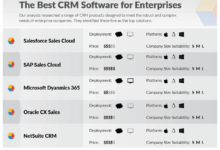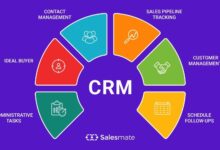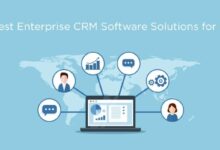Top Cloud-Based CRM Platforms
Top Cloud-Based CRM Platforms are revolutionizing how businesses manage customer relationships. This shift from on-premise systems offers significant advantages, including enhanced accessibility, scalability, and cost-effectiveness. This exploration delves into the leading platforms, their features, and the crucial considerations for successful implementation, ultimately guiding businesses toward optimizing their customer interactions and achieving sustainable growth.
We’ll examine the evolution of cloud-based CRM, comparing key players like Salesforce, HubSpot, Zoho, Microsoft Dynamics 365, and Pipedrive, analyzing their strengths, weaknesses, and target audiences. The importance of seamless integration with other business tools and the critical aspects of security and data privacy will also be thoroughly addressed. Finally, we’ll provide practical advice on choosing the right platform and maximizing its potential.
Introduction to Cloud-Based CRM Platforms
Cloud-based Customer Relationship Management (CRM) platforms have revolutionized how businesses manage interactions with customers. Offering significant advantages over traditional on-premise systems, cloud-based CRMs are increasingly the preferred choice for organizations of all sizes. This section explores the benefits of cloud CRMs, their historical development, and the core features that define them.
Cloud-based CRM systems offer several key advantages over their on-premise counterparts. Primarily, they eliminate the need for significant upfront investment in hardware and software infrastructure. Businesses can access CRM functionality immediately, paying only for the services they use, typically on a subscription basis. This scalability allows companies to easily adapt their CRM capacity to meet fluctuating business needs, adding or reducing users as required. Furthermore, cloud-based systems often offer superior accessibility, allowing authorized personnel to access customer data from anywhere with an internet connection, improving collaboration and responsiveness. Reduced IT maintenance and enhanced security through the provider’s infrastructure are additional benefits.
Evolution of Cloud-Based CRM
The evolution of cloud-based CRM mirrors the broader adoption of cloud computing. Early CRM systems were primarily on-premise solutions, requiring dedicated servers and IT personnel for installation, maintenance, and updates. The rise of the internet and the development of Software as a Service (SaaS) models in the late 1990s and early 2000s paved the way for cloud-based CRM. Initially, these cloud offerings were relatively basic, but rapid technological advancements and increased internet bandwidth led to the development of increasingly sophisticated and feature-rich platforms. The shift towards mobile accessibility further accelerated the adoption of cloud-based CRMs, as businesses sought to empower their sales and customer service teams with anytime, anywhere access to customer information. Major players like Salesforce emerged as pioneers, establishing the foundation for the modern cloud CRM landscape.
Key Features of Cloud-Based CRM Platforms
Most cloud-based CRM platforms share a core set of features designed to streamline customer interaction management. These typically include contact management, enabling the storage and organization of customer details; sales force automation, automating tasks like lead tracking and opportunity management; marketing automation, facilitating targeted marketing campaigns and customer segmentation; customer service tools, including ticketing systems and live chat functionalities; and reporting and analytics dashboards, providing valuable insights into customer behavior and sales performance. Many platforms also offer integration capabilities with other business applications, such as email marketing platforms and accounting software, enhancing efficiency and data consistency. The specific features and functionalities offered can vary considerably between different platforms, reflecting the diverse needs of different businesses. For example, some platforms might offer advanced features such as predictive analytics or artificial intelligence-powered customer support, while others might focus on simpler, more user-friendly interfaces suitable for smaller businesses.
Top Platforms
Choosing the right cloud-based CRM can significantly impact a business’s efficiency and growth. This section provides a comparative overview of several leading platforms, highlighting their key features, pricing, and target audiences to aid in informed decision-making.
Comparative Overview of Top Cloud-Based CRM Platforms
The following table compares five popular cloud-based CRM platforms. Note that pricing can vary significantly based on the number of users, features selected, and contract length.
| Platform Name | Key Features | Pricing Model | Target Audience |
|---|---|---|---|
| Salesforce | Sales force automation, marketing automation, customer service, analytics, app marketplace, extensive customization options. | Subscription-based, tiered pricing with various options and add-ons; can be expensive for smaller businesses. | Large enterprises, businesses with complex sales processes, and those requiring high levels of customization. |
| HubSpot | CRM, marketing automation, sales automation, service hub, CMS, strong free plan options. Excellent for inbound marketing strategies. | Freemium model; paid plans offer increasing functionality and user capacity. | Small to medium-sized businesses (SMBs), marketing-focused businesses, and those prioritizing inbound marketing. |
| Zoho CRM | Sales force automation, marketing automation, customer service, project management tools, integrations with other Zoho applications. Offers a comprehensive suite at a relatively lower cost. | Subscription-based, tiered pricing with various features and user limits. Generally more affordable than Salesforce. | SMBs, businesses seeking an all-in-one solution, and those looking for cost-effective options. |
| Microsoft Dynamics 365 | Sales force automation, customer service, marketing automation, project management, ERP integration. Tight integration with the Microsoft ecosystem. | Subscription-based, modular pricing allowing businesses to choose specific modules based on needs. | Large enterprises, businesses already heavily invested in the Microsoft ecosystem, and those requiring robust ERP integration. |
| Pipedrive | Sales pipeline management, deal tracking, contact management, email integration, focused on sales process efficiency. Simple and intuitive interface. | Subscription-based, tiered pricing with different features and user limits. Generally more affordable than Salesforce and Dynamics 365. | SMBs, sales-focused businesses, and those prioritizing a straightforward and easy-to-use platform. |
User Interface Comparison: Salesforce, HubSpot, and Zoho
Salesforce, HubSpot, and Zoho present distinct user interfaces. Salesforce, known for its extensive features, can appear complex to new users, with a steeper learning curve. Its interface is highly customizable, allowing users to tailor their experience, but this can also lead to inconsistencies if not managed properly. HubSpot, on the other hand, offers a more intuitive and user-friendly interface, particularly appealing to those new to CRM systems. Its clean design and straightforward navigation make it easy to learn and use. Zoho CRM falls somewhere in between, offering a reasonably intuitive interface with a good balance of features and simplicity. While it’s not as visually striking as HubSpot, it’s significantly less complex than Salesforce.
Strengths and Weaknesses of Each Platform
Each platform discussed has unique strengths and weaknesses. Salesforce, while powerful and customizable, can be expensive and complex. Its strength lies in its extensive functionality and scalability, making it ideal for large enterprises with intricate needs. HubSpot excels in its ease of use and strong marketing automation capabilities, but may lack the advanced features needed by larger organizations. Zoho offers a compelling balance of features and affordability, but its customization options may be less extensive than Salesforce. Microsoft Dynamics 365 leverages Microsoft’s ecosystem, providing seamless integration, but its complexity and cost can be barriers for smaller businesses. Pipedrive’s simplicity and focus on sales pipeline management are its key strengths, but it may lack the broader functionality offered by other platforms.
Integration Capabilities
A modern CRM’s effectiveness hinges significantly on its ability to seamlessly integrate with other business tools. This interconnectedness streamlines workflows, eliminates data silos, and provides a holistic view of customer interactions across various departments. Without robust integration, a CRM becomes an isolated system, failing to realize its full potential for improving efficiency and driving revenue growth.
The value of a well-integrated CRM extends beyond simple data consolidation. It allows for automated processes, improved data accuracy, and enhanced decision-making based on a comprehensive understanding of customer behavior and business performance. Choosing a CRM with strong integration capabilities is crucial for any organization seeking to maximize its return on investment.
Integration Methods
Different CRM platforms offer various integration methods, each with its own strengths and weaknesses. Understanding these options is crucial for selecting a system that aligns with an organization’s technical capabilities and specific needs.
- API Integrations: Application Programming Interfaces (APIs) provide a flexible and powerful way to connect a CRM with other software. APIs allow for custom integrations, offering maximum control and flexibility. This approach is ideal for businesses with unique requirements or complex integration needs. However, API integrations often require more technical expertise to implement and maintain.
- Pre-built Connectors: Many CRM platforms offer pre-built connectors for popular business applications. These connectors simplify the integration process, requiring minimal technical expertise. They offer a quicker and easier implementation compared to custom API integrations. However, pre-built connectors may not support every application a business uses, limiting flexibility.
Examples of Successful CRM Integrations
Successful CRM integrations can significantly impact various business processes. For example, integrating a CRM with marketing automation software allows for personalized email campaigns based on customer interactions tracked within the CRM. This targeted approach leads to improved conversion rates and enhanced customer engagement. Similarly, integrating a CRM with accounting software streamlines invoicing and payment processing, providing a more efficient financial management system. A company using Salesforce, integrated with Mailchimp for email marketing and QuickBooks for accounting, would experience streamlined workflows, improved data accuracy, and a more holistic view of customer interactions and financial performance. This integration eliminates manual data entry, reduces errors, and enables more data-driven decision-making.
Security and Data Privacy
Choosing a cloud-based CRM involves entrusting sensitive customer data to a third-party provider. Therefore, robust security measures and adherence to data privacy regulations are paramount. Understanding the security protocols and compliance certifications of different platforms is crucial for making an informed decision.
Security measures implemented by leading cloud-based CRM providers are multifaceted and constantly evolving. They typically involve a combination of technical safeguards, organizational policies, and legal compliance frameworks. This ensures data confidentiality, integrity, and availability.
Security Measures Implemented by Leading Cloud-Based CRM Providers
Leading providers employ a layered security approach. This includes infrastructure security, such as data centers with physical access controls and robust network security appliances like firewalls and intrusion detection systems. Furthermore, they utilize data encryption both in transit (using protocols like HTTPS) and at rest (using encryption algorithms like AES-256). Regular security audits and penetration testing are conducted to identify and address vulnerabilities proactively. Multi-factor authentication (MFA) is often mandatory for user access, enhancing account security. Data loss prevention (DLP) tools monitor and prevent sensitive data from leaving the system unauthorized. Finally, many providers offer features like role-based access control (RBAC) allowing administrators to granularly control user permissions.
Data Privacy Regulations and Compliance Standards
CRM data is subject to various data privacy regulations depending on the location of the data and the users involved. Key regulations include the General Data Protection Regulation (GDPR) in Europe, the California Consumer Privacy Act (CCPA) in California, and similar laws in other jurisdictions. Compliance often involves implementing data minimization practices, obtaining explicit consent for data processing, and providing users with control over their data (e.g., the right to access, rectify, erase, or restrict processing). Leading CRM providers typically demonstrate compliance through certifications like ISO 27001 (information security management) and SOC 2 (security, availability, processing integrity, confidentiality, and privacy).
Hypothetical Security Protocol for a Cloud-Based CRM Platform
A robust security protocol for a cloud-based CRM should incorporate several key elements. First, a zero-trust security model should be adopted, assuming no implicit trust and verifying every access request. This involves continuous authentication and authorization using MFA and RBAC. Data encryption at rest and in transit is essential, utilizing strong encryption algorithms and protocols. Regular security assessments, including penetration testing and vulnerability scanning, are crucial for proactive threat detection. Incident response plans should be in place to handle security breaches effectively. Data loss prevention mechanisms should be integrated to prevent unauthorized data exfiltration. Finally, comprehensive logging and monitoring capabilities are needed to track system activity and detect suspicious behavior. Regular security awareness training for employees is also critical. This multi-layered approach would help ensure the confidentiality, integrity, and availability of CRM data.
Scalability and Customization
Cloud-based CRMs offer a significant advantage over on-premise systems in their ability to adapt to the ever-changing needs of a business. This adaptability stems from their inherent scalability and extensive customization options, allowing businesses to seamlessly adjust their CRM to match their growth trajectory and evolving operational requirements. This flexibility is a crucial factor in maximizing the return on investment and ensuring long-term CRM effectiveness.
The inherent scalability of cloud-based CRMs allows businesses to easily adjust their resource allocation to meet fluctuating demands. This means that businesses can start with a smaller subscription and gradually upgrade to larger plans as their needs grow, without the significant upfront investment and infrastructure management associated with on-premise systems. This pay-as-you-go model reduces financial risk and allows for more efficient resource utilization.
CRM Customization Options
Many cloud-based CRM platforms offer a range of customization options to tailor the system to a company’s specific workflows and data requirements. These options significantly enhance the CRM’s usability and effectiveness, ensuring it aligns perfectly with the unique processes of the organization. These customization capabilities eliminate the need for complex and costly workarounds, improving overall efficiency and user satisfaction.
- Workflow Automation: Most CRMs allow for the automation of repetitive tasks, such as lead assignment, email sequences, and report generation. This automation frees up valuable employee time, allowing them to focus on higher-value activities. For example, a sales team could automate the process of sending follow-up emails to leads after a meeting, ensuring consistent communication and improving conversion rates.
- Custom Fields: Businesses can add custom fields to store specific data relevant to their operations. This allows for more granular data tracking and reporting, providing deeper insights into business performance. For example, a real estate company could add custom fields to track property details such as square footage, number of bedrooms, and lot size, information not typically included in standard CRM fields.
- Integrations with Third-Party Applications: Many cloud-based CRMs seamlessly integrate with other business applications, such as marketing automation platforms, e-commerce systems, and accounting software. These integrations create a unified view of customer data, improving collaboration and decision-making. For instance, integrating a CRM with a marketing automation platform enables targeted marketing campaigns based on customer data stored within the CRM.
Scaling a CRM Platform
Scaling a cloud-based CRM to accommodate a larger user base and increased data volume is typically a straightforward process. Cloud providers offer various scaling options, allowing businesses to seamlessly adjust their resources as needed. This scalability ensures that the CRM remains performant and reliable even during periods of rapid growth. Understanding these scaling options is crucial for maintaining operational efficiency and avoiding performance bottlenecks.
The process often involves upgrading to a higher subscription tier, which provides access to increased storage capacity, processing power, and user licenses. Some platforms also offer automated scaling features that dynamically adjust resources based on real-time demand. This ensures that the CRM always has the resources it needs to perform optimally, regardless of the current workload. For example, a rapidly growing startup might start with a basic CRM plan and then upgrade to a premium plan as its user base and data volume increase, ensuring continued smooth operation. This contrasts sharply with on-premise systems which require significant manual intervention and potentially costly infrastructure upgrades to handle increased demand.
Choosing the Right Platform
Selecting the ideal cloud-based CRM platform requires careful consideration of your business’s unique needs and priorities. The wrong choice can lead to inefficiencies, data silos, and ultimately, hinder your growth. A well-informed decision, however, can significantly improve sales, customer service, and overall operational effectiveness.
Choosing the right platform is a multi-step process that involves evaluating various factors and aligning them with your business goals. This involves not just assessing features, but also considering long-term scalability, integration capabilities, and the overall cost of ownership.
Decision-Making Flowchart for CRM Selection
A structured approach is crucial when navigating the diverse options available in the CRM market. The following flowchart provides a visual guide to assist businesses in making an informed decision.
Start → Define Business Needs (Sales, Marketing, Customer Service) → Identify Key Features (Contact Management, Sales Pipeline, Reporting) → Research Potential Platforms (Based on Features and Budget) → Compare Platforms (Pricing, Integrations, Security) → Trial/Demo Selected Platforms → Evaluate User Experience and Performance → Select Platform → Implement and Integrate → Monitor and Optimize → End
Factors to Consider When Evaluating CRM Options
Before committing to a specific CRM platform, it is essential to meticulously evaluate several key aspects. This checklist will guide you through the crucial factors to consider.
- Budget: Determine your allocated budget, considering licensing fees, implementation costs, and ongoing maintenance expenses. For example, a small startup might opt for a less expensive platform with limited features, while a large enterprise would require a more robust and scalable solution, even if it costs more.
- Features: Identify the specific functionalities your business requires. This might include contact management, sales pipeline management, marketing automation, customer service tools, and reporting capabilities. Consider whether the platform offers features that align with your current and future needs.
- Integrations: Assess the platform’s ability to integrate with your existing software systems, such as email marketing platforms, accounting software, and e-commerce platforms. Seamless integration minimizes data silos and streamlines workflows.
- Scalability: Ensure the chosen platform can accommodate your business’s growth. A scalable CRM can adapt to increasing user numbers, data volume, and evolving business requirements without significant disruptions.
- Security and Data Privacy: Prioritize platforms that offer robust security measures to protect sensitive customer data. Compliance with relevant data privacy regulations, such as GDPR or CCPA, is paramount.
- User-Friendliness: Opt for a platform with an intuitive interface that is easy for your team to learn and use. A user-friendly CRM ensures higher adoption rates and maximizes productivity.
- Vendor Support: Evaluate the level of support provided by the vendor. Reliable customer support is crucial for addressing technical issues and ensuring smooth operation.
Best Practices for Implementing and Managing a Cloud-Based CRM System
Successful CRM implementation goes beyond simply choosing a platform. Effective management is essential for realizing the full potential of the system.
- Data Migration Planning: Thoroughly plan the migration of existing customer data to the new CRM system. This process requires careful data cleansing and validation to ensure data accuracy and integrity.
- User Training: Provide comprehensive training to your team on how to effectively use the CRM system. Adequate training enhances user adoption and maximizes the system’s value.
- Process Optimization: Align your business processes with the CRM system’s functionalities. This ensures that the CRM supports and streamlines your workflows, rather than creating new inefficiencies.
- Regular Monitoring and Reporting: Continuously monitor the CRM system’s performance and generate regular reports to track key metrics. This enables you to identify areas for improvement and optimize the system’s effectiveness.
- Data Backup and Recovery: Implement a robust data backup and recovery plan to safeguard your valuable customer data against potential data loss or system failures.
Illustrative Examples of CRM Use Cases
Cloud-based CRM systems offer transformative potential across various industries. Their flexibility and scalability allow businesses of all sizes to streamline operations, improve customer relationships, and ultimately boost profitability. The following examples showcase how different organizations leveraged cloud CRM to overcome specific challenges and achieve significant improvements.
Real Estate Agency Streamlining Lead Management
A small real estate agency struggled to manage leads effectively using spreadsheets and email. Information was scattered, follow-ups were inconsistent, and tracking progress was nearly impossible. They implemented Salesforce Sales Cloud, a leading CRM platform known for its robust lead management capabilities.
- Salesforce’s lead capture and assignment features automated the process of distributing incoming leads to agents based on location and property type, eliminating manual sorting and ensuring timely responses.
- The integrated email and calendar functions allowed agents to schedule showings, send personalized follow-up emails, and track communication history, improving response rates and conversion rates.
- Salesforce’s reporting and analytics dashboards provided real-time insights into lead sources, conversion rates, and agent performance, enabling data-driven decision-making and improved resource allocation.
The agency experienced a 30% increase in lead conversion rates within six months of implementing Salesforce, attributed to improved lead management and enhanced communication.
Retailer Enhancing Customer Service and Loyalty
A national retail chain faced challenges in providing consistent customer service across multiple locations. Customer data was fragmented, making it difficult to personalize interactions and build customer loyalty. They adopted Microsoft Dynamics 365, a comprehensive CRM solution known for its customer service capabilities and integration with other business applications.
- Dynamics 365’s unified customer view consolidated customer data from various sources, including point-of-sale systems, website interactions, and customer service calls, providing a holistic understanding of each customer.
- The platform’s integrated customer service tools enabled agents to access complete customer history and preferences, allowing them to personalize interactions and resolve issues more efficiently.
- Dynamics 365’s loyalty program management features facilitated the creation and management of a loyalty program, rewarding repeat customers and driving increased sales.
The retailer saw a significant improvement in customer satisfaction scores and a 15% increase in repeat purchases after implementing Dynamics 365, demonstrating the power of a centralized customer view and personalized interactions.
Non-profit Organization Improving Donor Management
A large non-profit organization struggled to manage its donor database effectively. Tracking donations, managing communication, and analyzing donor engagement were manual and time-consuming processes. They adopted HubSpot CRM, a platform specifically designed for marketing and sales automation, known for its ease of use and affordability.
- HubSpot’s contact management features allowed the organization to centralize and organize donor information, including donation history, communication preferences, and engagement levels.
- The platform’s automated email marketing capabilities facilitated the creation and distribution of targeted fundraising campaigns, increasing donor engagement and contributions.
- HubSpot’s reporting and analytics tools provided insights into donor behavior and campaign performance, enabling data-driven decision-making and improved resource allocation for fundraising efforts.
The non-profit experienced a 20% increase in donations within a year of implementing HubSpot, showcasing the effectiveness of targeted communication and improved donor management.
Outcome Summary
Selecting the optimal cloud-based CRM platform requires careful consideration of various factors, from scalability and customization options to security protocols and integration capabilities. By understanding the unique strengths and weaknesses of each platform, businesses can make informed decisions that align with their specific needs and operational goals. Ultimately, the successful implementation of a cloud-based CRM system can significantly streamline workflows, improve customer relationships, and drive substantial business growth.





